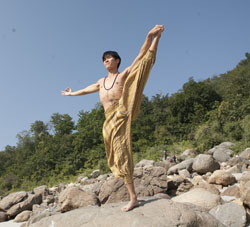If you have not yet tried Johnson’s classes, be sure to check them out! Be prepared for fabulous alignment based cues and adjustments, music that supports your yoga groove and a teacher who will leave you with a stronger understanding of your body. This up-and-comer will keep you focused and encourage you to meet your highest, purest self on the mat.
Johnson, when did you first discover yoga?
I discovered yoga during my first year of college. A friend of mine started a yoga club and yoga was also taught as one of the many movement courses through my acting conservatory training at SUNY Purchase.
How long have you been teaching?
Two years; I’m a young teacher. I received my original training through Joschi Yoga Institute, and from there, embarked on a Thai Yoga Massage training with Lotus Palm Thai Massage School. Now, I continue to study and teach the mind+body curriculum at Studio Anya, which is an in depth movement philosophy that incorporates yoga and pilates to facilitate profound change.
What makes your class unique?
I see what people are doing and adjust my cuing to who is taking class. Most of my cuing is anatomy based – lots of skeletal vocabulary to deepen people's spatial awareness in motion. Muscular shifts are very temporary, and the more people can deepen their relationship to their bones, the more successful the integration of these postures will translate into real life. My classes are also driven strongly through intention and dynamic meditation. The whole asana practice is one big moving meditation after all, and the better people can be about counting, breathing and listening intently all the while, the more receptive the nervous system will be to welcome well earned openings.
What is your favorite pose to teach?
Savasana. The best thing to teach bumbling and bustling New Yorkers on the go is how to be actively resting. Instead of going into an unconscious slumber, Savasana is an opportunity to witness the body and mind in a state of assimilation and integration. How does this help in real life? Well, instead of someone going into a panicked fight or flight frenzy running late for work, wouldn't Savasana be a good friend to have?
What is you favorite pose to practice?I love Savasana after a grueling and sometimes not so grueling class because that’s where it’s at for me. With the bodywork I do, there is quite a bit of energy manipulation, and transference. I tend to be a vacuum cleaner for a lot of people's junk, so savasana is a very necessary practice of shedding what's unnecessary. Every savasana is like a miniature unveiling of one piece of beautiful artwork that is hidden by gnarly cobwebs.
Best advice for beginners?One-on-one's are the way to go. Private instruction sets a firm foundation for people with specific issues that may come up for any beginner. In a private setting, a beginner eliminates the part of the ego that is trying to mimic everyone else in the group setting. Beginner's also have to take responsibility for themselves and not be afraid to ask questions, which is why a private setting is a better environment to start.
Best advice for more advanced yogis?
This is my advice to myself quite often: “Be humble and listen.” We all can fill in the blank and advise ourselves. We already know the answers to some degree.
What is your biggest yoga pet peeve?
Students instructing other students or friends in a class, or even going as far as adjusting them. We've all been the rogue high school student or at least have that rogue kid inside ready to go against the grain, which is fine, but it makes my job much more difficult.
Reader questions…
What are your hobbies?
I'm also a performer. I act, dance (modern) and do aerial silk work. Recently, was introduced to Budokon, which is yoga movement fused with martial arts movement. I used to practice kung fu, so I miss that Yang energy in yoga movement, and Budokon definitely covers it.
What is your favorite music to play in class and why?
It's hard for me to pick favorites because I switch in and out of states or moods so quickly. So music-wise, my one golden rule is that it should compliment what is being taught in class.
Why should a student from your York class come try your Hot class / and vice versa?
Any hot class is challenging, and I teach the “Open,” which is wicked intense but a great challenge for a York student if they want to put their sense of inner stillness to a test. How efficient can you be with your actions and breath? Can you still quell the excessive mind chatter in an extremes? These are all additional challenges if you feel like you’re plateauing. But of course everyone is different, so some nervous systems literally cannot handle the overheating of the hot studio, and should be mindful of just jumping into any random class. Again, taking responsibility is key.
People should come from Hot to York to really experience their asana practice. I think it’s good to notice that your practice doesn’t have to be this extreme sport. If Hot is yang, then York is yin, come experience more yin energy. Hot yogis are radical and extremists, sometimes overly so. Taking a restorative or gentle class will actually help tone your muscles by letting all that lactic acid pent up in the system to wash out a bit. Knowing when to pull back and finding softer hues on the palette is a good thing.


No comments:
Post a Comment